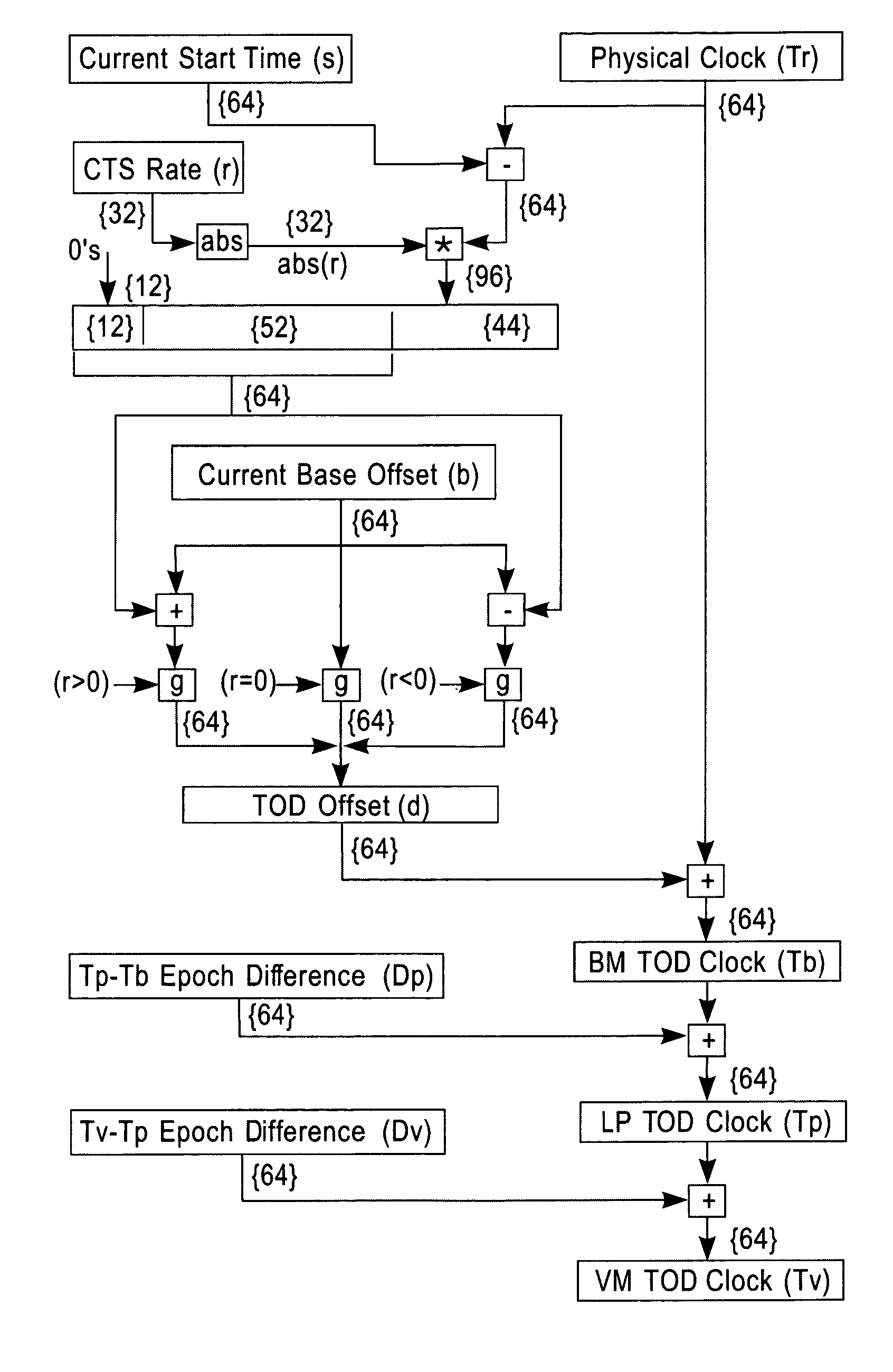Method and apparatus for adjusting a time of day clock without adjusting the stepping rate of an oscillator
a technology of time of day clock and oscillator, which is applied in the field of system and method of adjusting the time of day clock, can solve the problems of no longer meeting the architecture requirements of tod clock, the solution cannot be retrofitted to older machines, and the tod clock cannot meet the architecture requirements. achieve the effect of reducing overhead
- Summary
- Abstract
- Description
- Claims
- Application Information
AI Technical Summary
Benefits of technology
Problems solved by technology
Method used
Image
Examples
case 0
[0111]No offset change—No Failure: Table 1 shows proper operation of TOD clocks for the case when the offset is not changing.
[0112]
TABLE 1TOD bits55-60 atAction AtBoth CPUsCPU55CPU33Comments100 000STCK AA = . . . 100 101 101100 001100 010100 011100 100100 101100 110100 111LG 0,A(new value)101 000STCK BB = . . .101 011 011
[0113]The sum of the execution time of the store portion of STCK on the first CPU, plus the best-case CPU-to-CPU cache-to-cache transfer time from the first CPU to the second CPU, plus the execution time of LG and the access clock portion of STCK on the second CPU is called the best-case CPU-to-CPU clock-transfer time. To ensure correct operation for Case 0, the best-case CPU-to-CPU clock-transfer time must be at least 15.625 nanoseconds. This may be accomplished, if necessary, by artificially delaying the execution time of STCK on each CPU. An alternative, which will likely be required in future hardware, is to implement bits 58-63 of the physical clock, and the ma...
case 1
[0114]Negative Offset Change—Failure: Table 2 shows a synchronization failure of the TOD clocks when the offset is decreased by 15.625 nanoseconds (the smallest change possible for a negative steering rate on the preferred embodiment) and this change is not recognized at the same time on the two CPUs. (This failure occurs only if the architecture is not followed, as the architecture requires all CPUs begin using the new value at the same instant.) In this example, the failure occurs when CPU33 has begun using the new value and CPU55 is still using the old value. (Note that, as part of using the new value, CPU33 has already delayed long enough to ensure that the logical clock, as observed by CPU33 itself, does not appear to step backwards.)
[0115]
TABLE 2TOD ClockBits 55–60atatCPU55CPU33Action At(old)(new)CPU55CPU33Comments100 000011 000STCK AA = ...100 101 101100 001011 001100 010011 010100 011011 011100 100011 100100 101011 101100 110011 110100 111011 111LG 0,A(new value)101 000100 0...
case 2
[0117]Positive Offset Change—Failure: Table 3 shows a synchronization failure of the TOD clocks when the offset is increased by 15.625 nanoseconds (the smallest change possible for a positive steering rate on the preferred embodiment) and this change is not recognized at the same time on the two CPUs. (This failure occurs only if the architecture is not followed, as the architecture requires all CPUs begin using the new value at the same instant.) In this example, the failure occurs when CPU55 has begun using the new value and CPU33 is still using the old value.
[0118]
TABLE 3TOD ClockBits 55-60atatCPU55CPU33Action At(new)(old)CPU55CPU33Comments100 000011 000STCK AA = . . . 100 101 101100 001011 001100 010011 010100 011011 011100 100011 100100 101011 101100 110011 110100 111011 111LG 0,A(new value)101 000100 000STCK BB = . . . 100 011 011
[0119]To operate correctly for Case 2, the best-case CPU-to-CPU clock-transfer time must be at least 15.625 nanoseconds plus the absolute amount of t...
PUM
 Login to View More
Login to View More Abstract
Description
Claims
Application Information
 Login to View More
Login to View More - R&D
- Intellectual Property
- Life Sciences
- Materials
- Tech Scout
- Unparalleled Data Quality
- Higher Quality Content
- 60% Fewer Hallucinations
Browse by: Latest US Patents, China's latest patents, Technical Efficacy Thesaurus, Application Domain, Technology Topic, Popular Technical Reports.
© 2025 PatSnap. All rights reserved.Legal|Privacy policy|Modern Slavery Act Transparency Statement|Sitemap|About US| Contact US: help@patsnap.com



